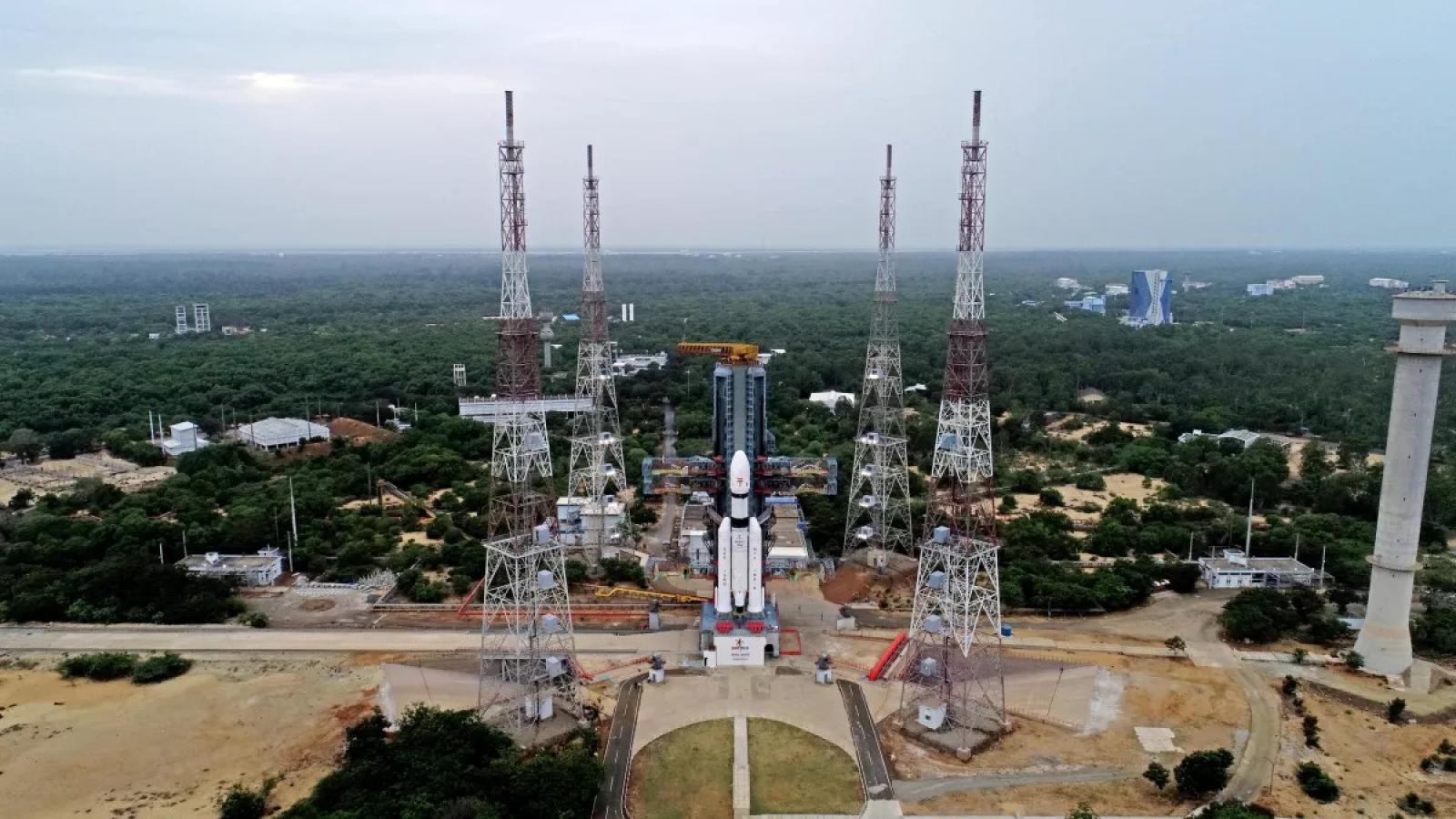India's ready to launch its Chandrayaan-3 moon-landing mission on July 14. Here's what to expect
By Sharmila Kuthunur

India's second attempt at a daring, homegrown moon landing will kick off this week.
The nation's Chandrayaan-3 mission, whose name means "moon vehicle" in Sanskrit, is scheduled to launch toward the moon on Friday (July 14) at 5:05 a.m. EDT (0905 GMT, or 2:35 p.m. local time on July 14) from the island of Sriharikota, on India's east coast.
A three-stage rocket called the Launch Vehicle Mark-3 (LVM3) will ferry the robotic moon lander and rover duo that make up the Chandrayaan-3 spacecraft into an Earth parking orbit, a stable circular path around Earth that allows the mission team to ensure all instruments are working well post launch. Soon after, the spacecraft will be placed on a lunar transfer trajectory, beginning its deep-space journey.
When Chandrayaan-3 nears our cosmic neighbor, its thrusters will fire up to nudge the spacecraft into a tight circular orbit around the moon until it is about 62 miles (100 kilometers) above the lunar surface. If all goes according to plan, the lander and rover will safely touch down on the moon's surface on Aug. 23 or Aug. 24.
The mission's success relies on a smooth landing of the spacecraft about 70 degrees from the moon's south pole. The landing will happen "only when the sun rises on the moon, to get 14 Earth days, or one lunar day, to work," said Arun Sinha, a former senior scientist at the Indian Space Research Organisation (ISRO), India's national space agency that is launching and operating this mission. If the team cannot land the spacecraft in August, the next window to do so will be a month later in late September, ISRO's chairman S. Somanath said at a press briefing last week.
The Chandrayaan-3 spacecraft includes a moon lander named Vikram (Sanskrit for "Valor"), which is equipped with four instruments to record thermal conductivity and sense moonquakes around the landing site, among other data.
Upon touchdown, the rover, Pragyan (Sanskrit for "wisdom"), will roll off Vikram and explore the nearby region, its onboard cameras helping it avoid lunar obstacles. It is expected to remain within the lander's field of view at all times while carrying out science experiments.
Pragyan has two instruments onboard to conduct on-site experiments, with which scientists hope to gain valuable technical data about the moon's makeup near the landing site. For example, similar to NASA's Curiosity rover that has been firing lasers at Martian rocks to study their composition (among other tasks), Pragyan has a laser spectrometer onboard that will zap lunar regolith in order to analyze and categorize the various gases released.
The solar-powered rover is expected to last at least one lunar day or 14 Earth days, although "there are faint chances of extra efficient battery charge," Sinha told Space.com. "If this is good, another 14 [Earth] days might be available."
The Chandrayaan-3 lander and rover are seen before being encapsulated in their payload fairing. (Image credit: ISRO)
The race to the moon
If the mission is successful, India will become only the fourth country to successfully soft-land a spacecraft on the moon, after the United States, the former Soviet Union and China. India may also become the first country to touch down near the moon's south pole, a region that has become a hotspot for future missions, thanks to its apparently abundant water ice, which will become an essential resource for future crewed missions to the moon and Mars.
"The south pole region has very different geology from the region around the [US] Apollo missions, so Chandrayaan-3 will provide a close-up view of an entirely new region of the moon," Marc Norman, a planetary geochemist at the Australian National University in Canberra, told Nature's T.V. Padma.
The Chandrayaan-3 mission, which costs nearly 6 billion rupees ($73 million), is a crucial endeavor for India, coming at a time when the country is one of many vying for the moon landing milestone.
Israel's first attempt, in April 2019, failed after an apparent engine failure that led the privately built spacecraft, Beresheet, to crash-land on the surface. Earlier this year, a private Japanese moon lander, Hakuto-R, also crashed after its onboard computers got confused by local terrain and caused the spacecraft to freefall from a higher-than-planned altitude. The teams behind both of those moon landing attempts plan to try again in the near future.
Those who have already made their mark in lunar exploration are also revisiting the moon. Russia's robotic Luna 25 mission to the moon — the first since the fall of the Soviet Union — is now scheduled to launch in August, with a planned landing near the lunar south pole. Next year, China's ambitious Chang'e 6 mission may collect samples from what is thought to be the oldest impact crater on the moon. And NASA's Artemis program plans to land astronauts on near the lunar south pole in 2025 or 2026.
India's Chandrayaan-3 moon mission and its LVM3 rocket stand atop their launch pad ahead of a planned July 14, 2023 launch. (Image credit: ISRO via Twitter)
- Se connecter ou s'inscrire pour publier un commentaire
- 18 vues
Connexion utilisateur
Dans la même rubrique
13/11/2025 - 10:20
de Philippe RICHARD
27/10/2025 - 12:20
URGéo-URBATER, Université d'État d'Haïti, Agence Kannh et le bureau d'étude et de conseils TCGNRG
22/10/2025 - 19:03
16/09/2025 - 15:48
05/09/2025 - 16:37
Commentaires récents
Elie Domota : "La gestion de l'eau en Guadeloupe est de la Mafia organisée !"
POI, je vois ce que vous voulez dire...
Frédéric C.
30/11/2025 - 15:40
...évidemment, qu’il y a des causes et des responsabilités (et des profiteurs, oui!) "endogènes" Lire la suite
Elie Domota : "La gestion de l'eau en Guadeloupe est de la Mafia organisée !"
Domota découvre l'eau (chlordéconée !!! ) chaude
poi
30/11/2025 - 13:40
Domota découvre l'eau chaude!! Il y a de la corruption en Gpe ..sans blague, pas possible !! Lire la suite
Le "Christ de Texaco" encourt 12 mois de prison avec sursis et 150.000 euros d'amendes
S'IL FALLAIT...
Albè
30/11/2025 - 12:25
...agresser verbalement tous les politiciens martiniquais accusés de malversations on n'en finira Lire la suite
Le "Christ de Texaco" encourt 12 mois de prison avec sursis et 150.000 euros d'amendes
En effet, S.Letchimy et D.Laguerre n’ont pas encore été...
Frédéric C.
30/11/2025 - 11:44
...jugés par le Tribunal. Lire la suite
Kréyolad 1102: Lajistis an manniman
BEK-YO...
Albè
28/11/2025 - 18:59
Sé wou ka pèmet FK viv ? FK dwé'w an bagay ? Sa ou ja fè pou ba'y an pal ? Lire la suite
Top 5 des articles
Aujourd'hui :
- Le "Christ de Texaco" encourt 12 mois de prison avec sursis et 150.000 euros d'amendes
- Elie Domota : "La gestion de l'eau en Guadeloupe est de la Mafia organisée !"
- Saint-Vincent : après 25 ans de règne, Ralph Gonzalves perd le pouvoir
- Et si un écrivain français, réfugié en Russie, écrivait que l'Alsace appartient à l'Allemagne ?
- Les Afro-Palestiniens de Jérusalem au coeur de la résistance
Depuis toujours :
- Tous les présidents et premiers ministres de la Caraïbe sont vaccinés
- L'intolérable appauvrissement intellectuel et culturel de la Guadeloupe et dans une moindre mesure de la Martinique !
- LETTRE OUVERTE AU 31ème PREFET FRANCAIS DE MARTINIQUE
- L'arrière-grand-père maternel de Joan Bardella était...algérien
- Les triplement vaccinés contre le covid ne bandent plus





